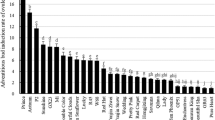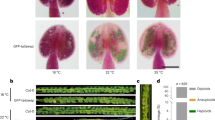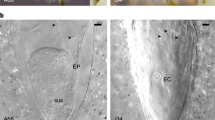Abstract
IF sterile immature anthers of Nicotiana tabacum (2n = 48) are cultured in an appropriate nutrient medium, the pollen may develop into plantlets with the haploid number of chromosomes1,2. When the plantlets have developed an adequate root system in the culture medium, they can be transferred to soil and grown to maturity. Reports differ, however, about the developmental stage at which the anthers must be cultured to ensure success. Plantlets were thought1 to be formed only if the pollen is initially in the tetrad condition; but many plantlets have been obtained2 using older anthers which undoubtedly contained separate pollen grains. We have attempted to resolve this difference, and to determine precisely the point at which transition to plantlet formation takes place. At the same time, we have studied the early divisions within the pollen at this transitional point. We now give a brief account of our findings.
This is a preview of subscription content, access via your institution
Access options
Subscribe to this journal
Receive 51 print issues and online access
$199.00 per year
only $3.90 per issue
Buy this article
- Purchase on Springer Link
- Instant access to full article PDF
Prices may be subject to local taxes which are calculated during checkout
Similar content being viewed by others
References
Nakata, K., and Tanaka, M., Jap. J. Genet., 43, 64 (1968).
Nitsch, J. P., and Nitsch, C., Science, 163, 85 (1969).
Author information
Authors and Affiliations
Rights and permissions
About this article
Cite this article
SUNDERLAND, N., WICKS, F. Cultivation of Haploid Plants from Tobacco Pollen. Nature 224, 1227–1229 (1969). https://doi.org/10.1038/2241227b0
Received:
Issue Date:
DOI: https://doi.org/10.1038/2241227b0
This article is cited by
-
Development of asparagus microspores in vivo and in vitro is influenced by gametogenic stage and cold treatment
In Vitro Cellular & Developmental Biology - Plant (1997)
-
Pollen dimorphism in soybean
Protoplasma (1993)
-
Structural changes during the first divisions of embryos resulting from anther and free microspore culture inBrassica napus
Protoplasma (1990)
-
Development of microsporesin vivo andin vitro inBrassica napus L.
Protoplasma (1988)
Comments
By submitting a comment you agree to abide by our Terms and Community Guidelines. If you find something abusive or that does not comply with our terms or guidelines please flag it as inappropriate.



